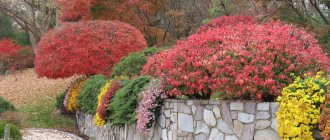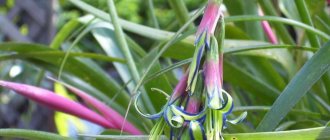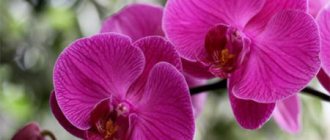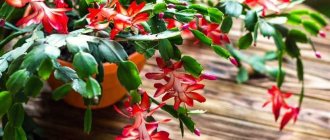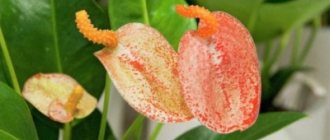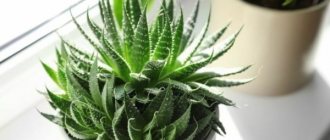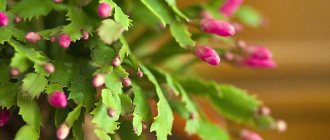Aptenia plant literally translates as “wingless” or a flower that begins to open its petals at noon. This succulent belongs to the Aizaceae family.
Aptenia has large fleshy shoots, its leaves are shaped like a heart. The inflorescences are small, pink, red or blue, formed on the side shoots .
Flowering time
Flowering of the crop is observed throughout the warm period of the year from April to the end of August.
Inflorescences appear at lunchtime, but the flowers do not always open fully ; this requires good, bright lighting.
Important! In winter, the plant goes into a dormant state to gain strength.
Varieties of aptenia
There are three types of athenia for growing in a flowerbed or in a room :
Apthenia cordifolia
Aptenia cordifolia is a fast-growing crop; the height of its shoots does not exceed 25 centimeters. The bush is spreading with fleshy branches of oval or tetrahedral shape . The shoots do not exceed 60 centimeters.
The leaves are fleshy, lancet-shaped, standard bright green in color, the length of the vegetative organs is up to 3 centimeters. The inflorescences are located one at a time on the plant, they are small with pink, purple or crimson petals.
The diameter of the flowers does not exceed 1.5 centimeters ; they are formed in the axils of the leaves, sometimes in the upper part of the shoots.
Apthenia lanceolate
It has dark green leaves shaped like a medical instrument with a rough surface. The stems are large, up to 80 centimeters in length, the flowers are beautiful, but small, consisting of many petals.
The inflorescences open only in good light, the petals are red or purple .
Aptenia variegata
Aptenia variegata differs from other varieties in the reduced size of the vegetative parts (inflorescences, shoots and leaves). Another distinctive feature of this crop is leaf spotting.
This is due to the presence of mutant cells in vegetative organs . They do not take part in the process of photosynthesis, resulting in a spotty color that is different from the standard. The spots can be of any size and shape.
Note! Variegated aptenia is considered a chimera crop, which complicates care. In such a plant, mutant cells exist at the expense of normally developed cells in which photosynthesis occurs.
Botanical description of the plant
According to the botanical description, apthenia is a succulent belonging to the Aizov family. It grows in the arid regions of South Africa and is also found in Australia, Oceania and the South American continent. The plant has powerful, although not very deep, roots, which provide a strong anchorage in dry sandy soil. The stems of apthenia are creeping, spreading and rather long. The leaves are fleshy, with small papillae over the entire surface, lanceolate or heart-shaped, located opposite on the stem.
Did you know? Aptenia is often called the "midday flower". It received a beautiful poetic name for its ability to fully open its buds only in bright light, which usually occurs at noon.
The succulent blooms with bright small (up to 1.5 cm in diameter) flowers, singly located in the axils of the leaves or on the tops of the stems. Flowering is intense and long - from spring to mid-autumn. The flowers are flat-rounded, consisting of many needle-shaped petals of scarlet, purple, mauve, and less often white. The buds open in the middle of the day. After flowering, a fruit is formed in their place, which is a capsule with several chambers, each of which contains 1 rather large dark brown seed with a rough shell.
| Root system | powerful, superficial |
| Stem | fleshy, creeping |
| Leaf Shape | lanceolate or heart-shaped |
| Leaf color | bright green or grayish |
| Flower shape | flat-round |
| Flower color | red, pink, purple |
| Shape of fruits (seeds) | multi-chamber capsule |
| Color of fruits (seeds) | dark brown |
Home care
even an inexperienced gardener can take care of apthenia at home .
The plant develops well in illuminated places, the surface of the leaves does not suffer from constant exposure to sunlight.
Lighting
Aptenia is considered a light-loving crop; when growing this plant at home, pots should be placed on the south-eastern or south-western window sills of the room .
In summer, at noon, crops are shaded or the temperature is reduced by ventilating the room. When there is a lack of lighting, athenia grows poorly, its shoots begin to stretch, and few inflorescences are formed.
Advice! In the summer, the pot with a flower is taken out to the terrace or balcony, and is gradually accustomed to natural light.
Some gardeners practice care and propagation in the open ground in a flower bed. This plant grows well, but it needs to be planted in places well lit by the sun .
In such areas, air currents always move, so the crop will not overheat. In winter, flower pots are placed on southern windowsills, where the lighting is maximum.
Temperature
In warm weather, the temperature in the room should be at 20-24 degrees . In autumn and winter, when the plant is dormant, it is reduced to 8-10 degrees.
Important! If it is not possible to observe the necessary regime during the wintering of aptenia, its shoots will stretch and the leaves will turn yellow, the crop will not be able to form inflorescences. If there is no cool room, add additional lighting with fluorescent lamps with a power of 50 watts or higher.
Watering
It is necessary to moisten the soil under the plant regularly in summer and spring; in winter, watering is reduced. Such work is carried out as the earthen coma dries out; excess moisture in the soil will cause rotting of the roots.
Air humidity
Dry air does not affect the development of the crop; there is no need to spray the leaves. In winter, place the flower away from heating devices so that it does not overheat.
As you know, apthenia can absorb the required amount of moisture from the air. To do this, place a small container of liquid next to the pot.
Top dressing
, liquid fertilizers with a minimum amount of nitrogen are applied during aptenia . The frequency of fertilization is once every two weeks.
The soil
is suitable for growing a flower , but you can make the soil yourself . For this you will need:
- 1 part turf soil;
- 1 part leaf soil;
- 1 part peat;
- 1 part sand.
Note! After thoroughly mixing all the components, add a little lime to the composition to reduce the acidity of the soil.
Rest period
To get good, abundant flowering, the apthenia must rest. The dormant period of this plant begins in the last ten days of October and ends in mid-March .
When setting the crop to rest, the temperature indicators are maintained at 8-10 degrees ; with an increase in indicators, foliage may fall and there will be no flowering.
Important! If the gardener cannot find a cool room in the apartment, he should install additional lighting above the crop, for example, fluorescent lamps, which will promote the normal development of aptenia.
Trimming
The plant does not receive stress after formative pruning. Similar work is carried out in the autumn or spring , but in this case the crop blooms later.
Aptenia may shed some of its leaves in winter. In this case, pruning of the bush should be done in February.
Advice! Use cuttings left over from autumn pruning for rooting. This way you can get additional plants.
Transfer
The root system of aptenia is characterized by intensive growth rates, so the crop needs to be replanted once every two years.
Similar operations are carried out in the spring, for this purpose a pot of larger diameter is selected and a small layer of pebbles or expanded clay is poured onto the bottom.
At the next stage of work, we remove the plant from the old container using the transshipment method, so as not to damage the earthen ball. Then we compress the crop with new soil prepared from turf and leaf soil, coarse sand and peat.
The first watering of the crop is carried out 3-5 days after transplantation . It is recommended to use warm water to moisturize.
This video talks about growing apthenia and shows how to transplant a plant by transshipment.
Watering and humidity
The air may be dry, but not hot. Aptenia will appreciate care in the form of spraying and washing the leaves, especially in spring and summer. When irrigating the plant, the soil in the planting container can be covered with polyethylene and the pot can be tilted. All dust is easily washed off under running water. In autumn and winter, these procedures can harm aptenia.
Watering is necessary whenever the top layer of soil dries out. The volumes of water should be large, and the procedure itself should be regular in warm seasons, and rare in winter. When using tap water, it must first be cleaned of harmful impurities.
Fertilizers
Such succulents as Apthenia variegata and its other species prefer regular feeding. Complex preparations should be applied once every 30 days from March to August. Those with a low nitrogen content are used. By violating an immutable rule, you can allow it to rot.
Transfer
Considering that the rhizome of apthenia consists of many shoots, thick and quite powerful. They are heavier than the plant itself and fill the flowerpot from the inside very quickly. As soon as this happens, you should start replanting. On average, this happens once a year, preferably in the spring.
Pruning: frequency and necessity
To form mesembryanthemum shoots, pruning should be carried out, which is easy for the plant. Molding is best done in the fall. But in conditions where the shoots of the succulent have become bare over the winter, it is better to prune the branches no later than February.
Reproduction
There are several options for propagating apthenia. Let's take a closer look at each of them.
Seed method
In this case, surface sowing of grains into a nutrient substrate consisting of light- textured soil or moistened sand .
Seeds germinate quickly, but for this you need to provide favorable conditions - good lighting, as well as a temperature within 21-24 degrees.
Young plants are watered with a moderate amount of water ; with constant intensive watering, the root system rots.
Cultures are transplanted into separate containers at one month of age. For their normal development, a nutrient mixture of turf and leaf soil and sand . All of these components are mixed in equal proportions.
Flowers are placed in a shaded place where the temperature is maintained at 16 to 18 degrees. Plants are watered every day using water at room temperature .
Cutting method
This video tells how to care for the interesting and unpretentious plant Apthenia and shows its propagation by cuttings.
The vegetative parts that remain
after pruning are stored in a shaded, dry room for 2-3 hours.
After this, the vegetative organs are planted in containers with wet sand, as shown in the photo. Important! For rooting, you can place the cuttings in water with the addition of coal. When the first roots appear, they are moved to separate containers and cared for like other plants.
Growing rules
Every problem that arises with young athenia is a litmus test of the care provided to the plant:
- If the leaves fall, this indicates waterlogging or drought in the soil mixture;
- Falling leaves in autumn or winter indicates increased indoor temperatures. Simply transporting it to a more suitable location can save the plant;
- If there is no flowering, it means that the winter conditions were too “greenhouse” and there was not enough lighting.
Watering and lighting are the main actions that will ensure the health and powerful flowering of apthenia.
Diseases and pests
Aptenia resists the effects of various diseases well and is not damaged by pests. Problems with flower development arise due to improper care .
Thus, the cause of leaves falling on a crop is improper watering (drying out the soil or stagnant moisture in the pot), as well as overwintering the plant in a warm room.
Lack of flowering occurs due to a lack of natural light or the absence of a dormant period for the plant. Follow the rules for caring for aphthenia and you will get a beautiful lush flower with a huge number of inflorescences.
Possible problems
An indoor succulent plant such as athenia is highly resistant to diseases and pests. However, if the shrub is not properly cared for or provided with unsuitable conditions for growth, this can cause problems such as:
- Lack of flowering . During the dormant period, the plant was not provided with optimal conditions. The temperature in the room was excessively high. This problem can also arise due to poor lighting. Then the bush must be moved to a brighter place.
- Flying leaves . The wrong watering regime has been chosen for the plant: there is stagnation of moisture in the substrate or the earthen clod has dried out. To stop the leaves from flying around, you need to adjust the watering regime.
- The appearance of rot . This may be due to excessively frequent applications of fertilizers containing nitrogen to the substrate. This may also be due to too frequent or excessive watering. Remove the bush from the pot and cut out any damaged parts. Then plant it in new soil mixture. Choose a more suitable watering regime for the plant and feed it only when absolutely necessary.
- Flying around the lower leaf plates . Most likely, the bush needs anti-aging pruning, which should be done as soon as possible. Or he spent the winter in an excessively warm place. In this case, it will take some time for the plant to adjust to the changing seasons. All you have to do is wait.
- Thin and very large leaf plates . This may be due to excessive addition of nitrogen-containing fertilizer to the substrate, or the wrong soil mixture was initially chosen (contains a lot of nutrients). Replanting in a suitable soil mixture will help. This may also be due to excessively poor lighting. Just move the bush to a brighter place.
- Pests . At home, pests almost never settle on this shrub. Mealybugs and aphids can settle on shrubs taken outside for the summer. You can get rid of them using a suitable insecticide.


